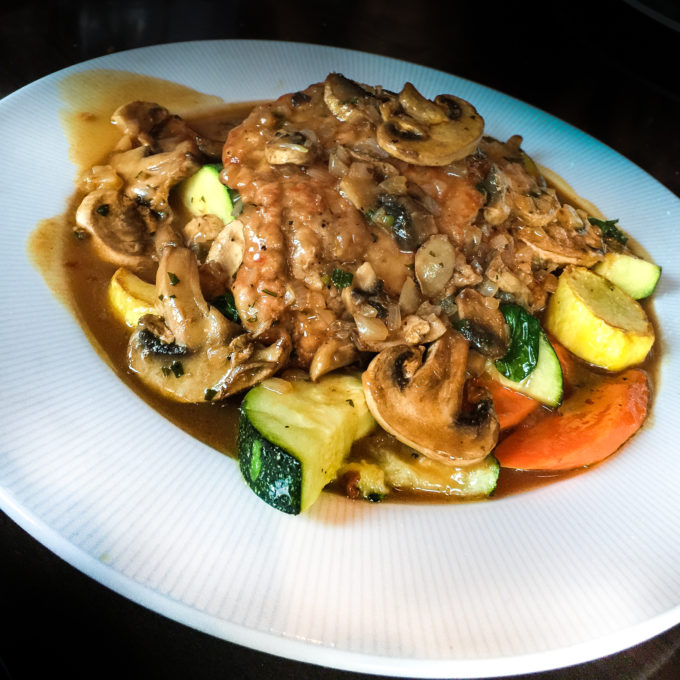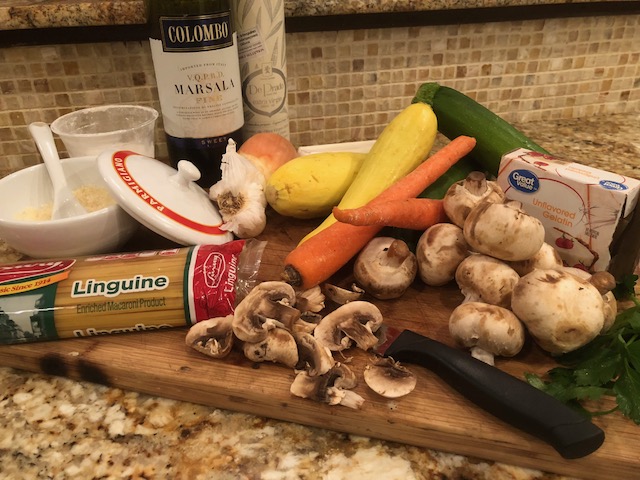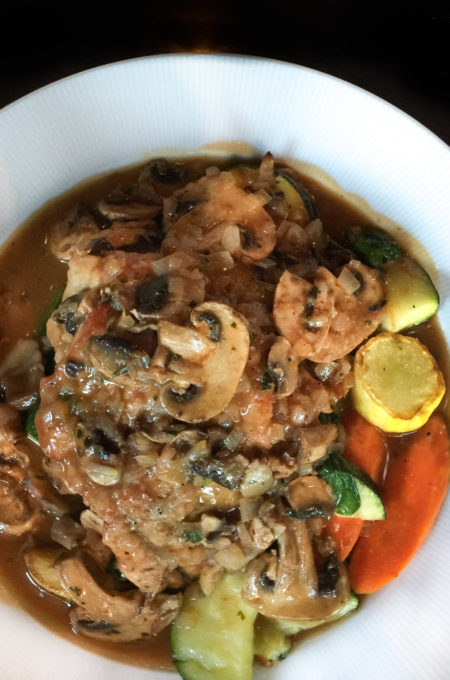A boneless breast of chicken pounded a la scallopini, seasoned, breaded, and pan-fried in olive oil and butter is a thing of beauty. But when ignited with a splash of intense Marsala wine and infused with garlic and mushrooms, these ingredients come together in a masterful Chicken Marsala that defines old-school Italian cooking for me.

With a velvety sauce, this Chicken Marsala defines classic Italian cooking. (All photos credit: George Graham)
So what’s the Louisiana connection to this dish? Except for the cast-iron skillet and a bit of Cajun spice, not much. But you could draw a parallel between the rich, panéed meat dishes and smothered cast-iron classics of our Cajun recipe playbook. Or you could point to the generational Sicilian heritage of many who live in South Louisiana. Truth is, the method used in this dish is at home in the Acadiana kitchen, but the ingredients (mushrooms and Marsala) explore new tastes. And isn’t that what cooking is all about?
The key to this dish is the wine that produces a sweet, smoky glaze-like sauce. Fortified wines and liqueurs are the hidden secrets of chefs and home cooks worldwide. I’ve cooked with them for years, and you can see their influence in many of my recipes like Wild Goose in Red Wine Gravy, or my Soup Bone Osso Buco, or even my Stuffed Chicken in Mushroom Madeira. In my focus on the cooking of the South, I tend to think globally and borrow techniques and ingredients to infuse my recipes using the indigenous ingredients I find close to home.
Whenever I see the word “Marsala” on a menu, it grabs my attention. Not sure why, but I get a romantic feel of red-checkered tablecloth Italian-American eateries with a little white-haired nonna serving up large bowls of pasta and basket-encased bottles of Chianti all to the soundtrack of Louis Prima singing Buona Sera. But truth be told, it’s the distinctive flavors of this cooking wine that hails from its namesake town in Sicily that draws me in every time.
Like port and sherry, Marsala is a fortified wine in which another spirit has been added to boost the alcohol content. While some Marsala wines are aged for up to ten years, most used for cooking are not. Some of these wines tend to be on the overly sweet side, so look for a dry Marsala that delivers a smoky, nutty flavor profile that I find irresistible in savory dishes like this one.
There was a time that veal Marsala was the defining dish on most southern Italian menus, and these days a chicken version has become even more prevalent. Over the years, I’ve had dozens of these Marsala-infused dishes with mostly good results. Not southern Italy, but it was a remarkable evening in a little ristorante in southern California that I had the defining chicken Marsala of my life.
Vitello’s in Studio City is a supper club restaurant that feeds a hungry neighborhood crowd. I’ve been coming to this little joint for years, and when my daughter lived in Los Angeles, it became a must-visit when I’m in the Valley. This contemporary kitchen does all the Italian classics while staying true to old-world tastes and methods. I applaud their attention to detail.
Give this recipe a try, explore the flavors of Marsala, and bring out the Italian lover in you.

Fresh ingredients splashed with Marsala wine for a tasty Chicken Marsala.
- 1 cup chicken stock
- 1 cup dry Marsala wine
- 1 packet unflavored powdered gelatin (optional, see Notes)
- 4 large skinless, boneless chicken breasts
- 1 cup all-purpose flour
- 1 teaspoon Acadiana Table Cajun Seasoning Blend, see recipe here
- 2 tablespoons olive oil
- 2 tablespoons unsalted butter
- 2 cups sliced mushrooms, such as button or portobello
- 1 cup chopped yellow onion or shallots
- 1 tablespoon minced garlic
- 1 cup thickly sliced yellow squash (optional)
- 1 cup thickly sliced zucchini (optional)
- 1 cup chopped carrot (optional)
- 2 tablespoons chopped flat-leaf parsley
- Parmesan cheese
- 1 tablespoon butter
- Kosher salt and freshly ground black pepper
- 1 pound cooked linguine noodles tossed with olive oil
- Combine the chicken stock and Marsala wine in a mixing bowl, and sprinkle in the packet of gelatin. Stir and let sit at room temperature until ready to use.
- Place each chicken breast between two sheets of plastic wrap and pound with a kitchen mallet (or a small saucepan) until about ½-inch thick. Season the flour and lightly coat each chicken breast with flour; shake off any excess.
- In a large cast-iron skillet over medium-high heat, add the oil and butter. Once sizzling, add the chicken and cook until just browned on both sides, about 5 minutes total. Remove to a platter and keep warm.
- In the remaining grease, add the mushrooms and cook until they are browned, about 8 minutes. Add the onion and garlic and sauté until the onion turns translucent, about 5 minutes.
- Add the stock and wine mixture (spoon out any gelatin in the bowl) and deglaze, scraping the bottom of the pan. Boil the liquid for 3 minutes to remove some of the alcohol and lower to a simmer. Add the squash, zucchini, carrot, and parsley, and cook until the sauce reduces by half and begins to thicken, about 8 minutes.
- Return the partially cooked chicken to the pan. Lightly sprinkle the pan with Parmesan cheese. Continue to simmer until the chicken is fully cooked and the sauce thickens enough to coat the back of a spoon, about 8 minutes. Stir in the butter to add a finishing sheen to the sauce. Season to taste with salt and pepper.
- Serve on a platter family-style or plated individually. Serve with noodles on the side.

Full of bold flavors that define Italian cooking.
YOUR SEAT AT THE TABLE: If you like this Cajun cooking story and Cajun recipe then accept my personal invitation to subscribe by entering your email at the bottom or top right of this page. It’s quick and painless. You will receive an email alert and be the first to see when new Cajun cooking stories and Cajun recipes are added. Thanks, George.
This appears to be a very sumptuous recipe. I will in the very near future prepare and make this dish..also sir, can you point out some real evoo..there is so much fake stuff on the market..i would just need brand names not markets..thank you for your diligence in bringing forth your wonderful recipes.
Merriell-
Thanks for the compliments; I hope you make this dish soon. As for olive oil, I agree that most commercially bought olive oils are inferior in quality and do not deserve the “extra virgin” distinction. And more to the point, most consumers purchase “Italian” olive oils thinking they must be quality, when those brands are the biggest culprits in the olive oil rip-off that has taken over the American market. Without naming a brand, I urge you to find a specialty store and search out American-made products (usually California) that are small-batch operators that have a solid reputation. Some of those shops even have tasting rooms that will allow you to compare flavor profiles. Also, unless you are using large quantities of olive oil, I urge you to buy it in small bottles for maximum freshness; it will decline in quality or go rancid in no time at all.
I LOVE Chicken Marsala and will likely add Cajun spice next time. hard to find a good bottle around here (small town, though lots of Italians), so have to do the best I can sometimes.
Your comment that you’ve long cooked with wine put me in mind of a kitchen sign a friend once gave me: “I cook with wine. Sometimes I even put it in the food!” It also reminded me of ‘that other’ Cajun chef Justin Wilson, famous for ‘Put a little wine in the pot, put a little wine in the chef.’
Okay, once again George, you have gotten my attention with a recipe for a dish that I have always wanted to try making myself, but never have. I have made up my mind now, I am going to go for it. With your directions and recipe, one evening this month a couple in NC will be having this for dinner at home, instead of a restaurant. If mine comes out as delicious as yours looks and sounds, this would be a great go to recipe for the rotating Supper Club my husband and I take part in. YAY! Also, thank you for the information on how long an open bottle of Marsala should be useable. What a struggle I have trying to figure out when it’s time to toss Brandy’s, Cognac, heck all spirits!
Hey Linda – Your friends in NC are lucky to know an adventurous cook who isn’t afraid to venture into new territory. You clearly understand that cooking dishes that are foreign to your comfort zone is fun and rewarding, and the discovery of new tastes to share with friends is the ultimate prize. All the best on your tasty travels through the culinary world.
Veal Marsala being one of my favorite dishes, I can’t wait to try this.
Hey George, I’ve enjoyed your newsletter since the beginning. I grew up in Lafayette, but have been in Los Angeles since 1989. It was good to hear you mention Vitello’s, one of the great old school Italian joints in town. Presently, there’s not a lot going on upstairs there, but in the past it has been a great spot for live jazz as well.
Hey Michael – Yep, Vitello’s is the real deal, and it is great to hear that you are a fan as well. Live music upstairs ups the cool factor, and during one evening we were there, Frank Stallone (Sylvester’s brother) was doing a set. All the best from your hometown.
I made this last night, and it was very good. The chicken breasts these days are so enormous that I took three and cut each in half for six pieces, and even those were big.
I have never cooked a hot dish using gelatin before (used it in other things). Because it is utilized as a thickening agent, would it be possible to substitute a very small bit of cornstarch instead? If not, when you say remove extra gelatin, are you referring to skim the top or any residue at the bottom? Thanks!
Hey Roxie- Good question. To clarify: If you make your chicken stock from bones, you may not need the gelatin; gelatin gives the sauce a thick, velvety texture that is the signature of a glaze-like Marsala sauce. You can certainly substitute a cornstarch slurry, but give this gelatin technique a try and taste the difference. All the best.